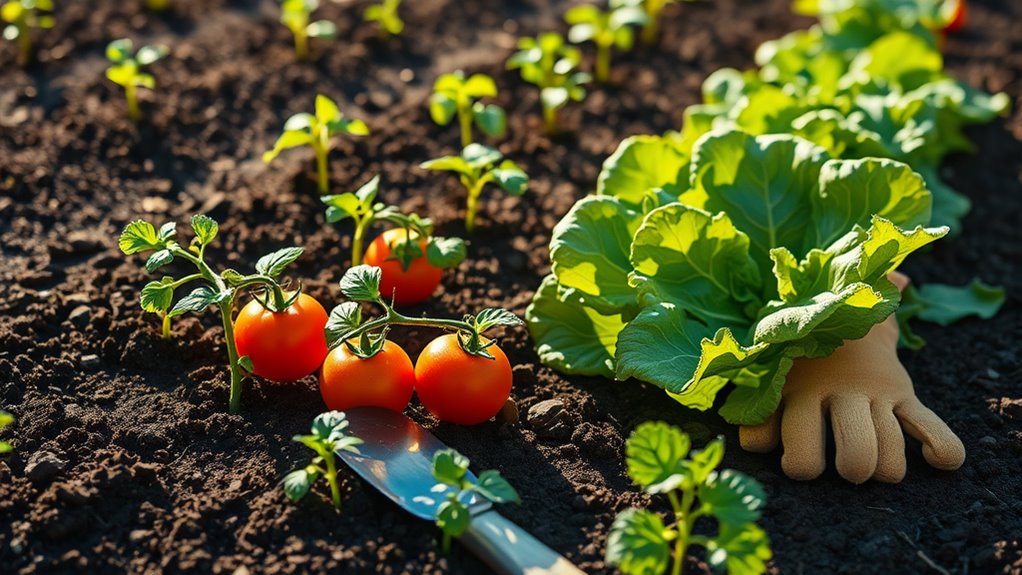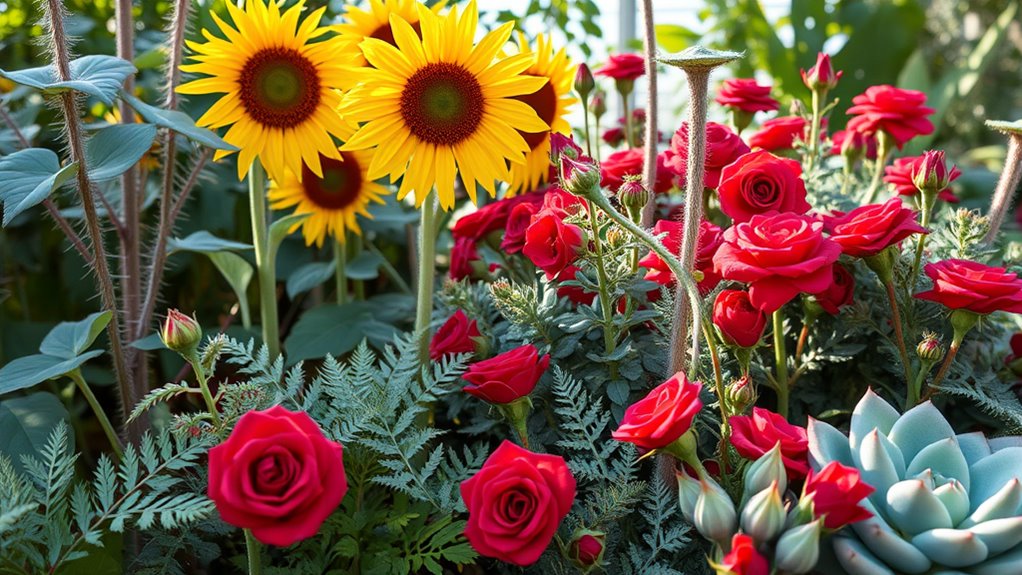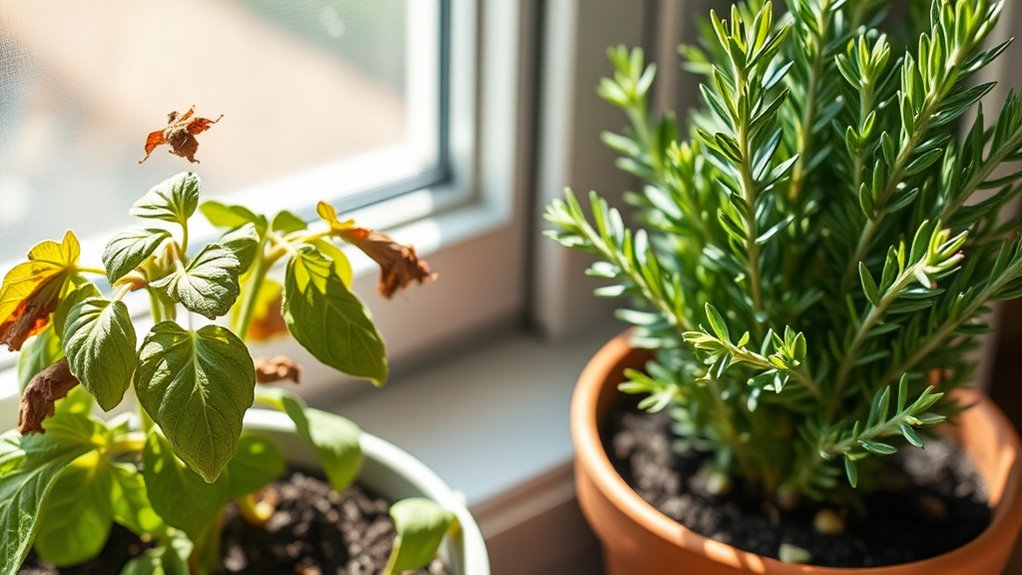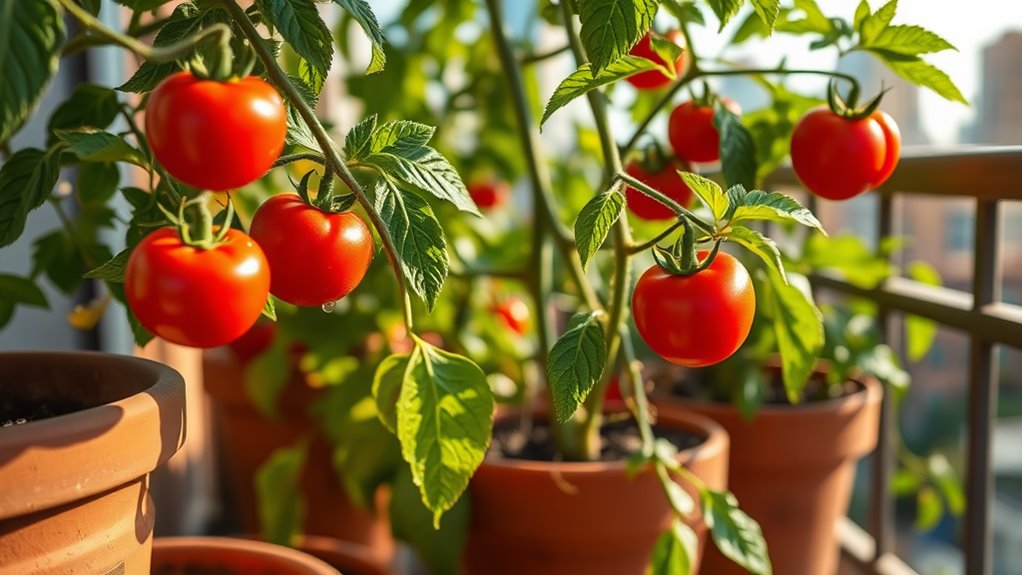The No-Fail Plan for Your First Vegetable Garden
Start your first vegetable garden on the right foot by picking a sunny, wind-sheltered spot with easy access. Test and enrich the soil with compost, then choose beginner-friendly plants that suit your climate and tastes. Plant seeds at the proper depth and spacing for strong growth. Keep up with daily watering, pest checks, and mulching to maintain healthy plants. Harvest ripe veggies for maximum flavor, and you’ll uncover more tips to ensure your garden flourishes.
Key Takeaways
- Choose a sunny, sheltered spot and prepare soil with compost for optimal growth.
- Select easy-to-grow plants that match your climate and personal preferences.
- Water consistently, monitor pests, and maintain soil moisture regularly.
- Implement a smart watering schedule and use companion planting for better yields.
- Harvest ripe produce in the morning and enjoy it fresh in meals.
Choosing the Right Location
When you’re planning your first vegetable garden, choosing the right location sets the foundation for success, as it directly influences sunlight, soil quality, and plant health.
In your vegetable gardening guide, prioritize a spot with at least six hours of daily sunlight to boost growth and yields.
Select an area sheltered from strong winds to protect delicate plants, and ensure easy access for watering and maintenance.
Proximity to your home encourages regular care, preventing neglect.
This strategic decision maximizes productivity and minimizes issues, making your first garden thrive effortlessly.
To ensure optimal growth, pay attention to soil preparation by testing and amending the soil as needed.
Additionally, incorporating uncomplicated methods from beginner-friendly resources will help you achieve successful growth with ease.
Preparing the Soil
Once you’ve selected the perfect spot for your garden, it’s time to prepare the soil for optimal growth. By performing soil testing, you can identify and remedy issues that might hinder your garden’s success.
You’ll begin by testing your soil to understand its needs, then add compost to enrich it, and finally till the ground to create a loose bed.
This process sets the foundation for healthy vegetables, so get started right away.
Additionally, soil testing can increase crop yields by addressing potential nutrient deficiencies.
Soil Testing
Testing your soil marks the essential first step in preparing it for a thriving vegetable garden.
You’ll assess its pH and nutrient levels to match your veggies’ needs, avoiding potential pitfalls like poor growth. Grab a simple, affordable test kit from a garden store or send a sample to a lab for professional results.
Interpret the data carefully: aim for a pH between 6 and 7, and identify deficiencies in nitrogen, phosphorus, or potassium. This empowers you to make targeted adjustments, setting the stage for robust plants and bountiful yields without guesswork.
Act now for optimal results.
Adding Compost
Step 2: Add compost to your soil for a nutrient boost, enhancing its texture and fertility while correcting any imbalances from your tests.
You’ll source high-quality, well-rotted compost from your backyard pile or a reliable supplier—aim for organic to avoid chemicals.
Spread a 2-3 inch layer evenly across your garden bed, ensuring even coverage. This enriches microbial activity, boosts moisture retention, and supplies essential nutrients like nitrogen and phosphorus.
Monitor your soil’s pH afterward to confirm improvements, setting the stage for thriving plants without overwhelming the ecosystem.
Always apply based on test results for precision.
Tilling Ground
With your compost now enriching the soil, you’ll till the ground to mix it in thoroughly, breaking up clumps and improving aeration for better root growth. Use a garden fork or tiller to loosen soil 6-12 inches deep, removing rocks and weeds as you go—it’s essential for healthy roots. Choose the right method based on your space.
| Tilling Method | Key Benefit | Best For |
|---|---|---|
| Hand Forking | Minimal soil disturbance | Small plots or raised beds |
| Rotary Tiller | Quick, even mixing | Larger gardens |
| No-Till | Preserves soil structure | Eco-friendly approaches |
| Double-Digging | Deep aeration | Clay-heavy soils |
This prepares your bed for planting success.
Selecting Your Plants
How do you choose the right plants for your first vegetable garden? Begin by assessing your local climate, available space, and gardening goals to ensure success. Focus on varieties that match your zone’s conditions and your skill level for a rewarding harvest. To make gardening more accessible, consider incorporating low-effort plants that thrive with minimal care and offer great benefits for beginners. For a seamless start, explore the seven low-maintenance vegetables that are ideal for beginners to grow with ease.
-
Evaluate your climate zone: Select plants suited to your USDA hardiness zone to avoid failures.
-
Consider garden size: Choose compact or container-friendly options if space is limited.
-
Prioritize beginner ease****: Opt for hardy veggies like radishes or beans that require minimal care.
-
Match personal tastes****: Pick what you’ll actually eat, such as tomatoes or herbs, for motivation.
-
Balance variety: Include a mix of fast-maturing and longer-season plants for ongoing yields.
Planting the Seeds
Now it’s time to choose your seeds carefully, selecting varieties that suit your climate and soil for the best results.
Once you’ve got the right ones, you sow them at the correct depth and spacing to ensure strong germination.
This step kickstarts your garden’s growth and sets you up for a bountiful yield.
Before sowing, focus on soil preparation techniques to create an ideal base for your seeds.
Additionally, consider your garden location when selecting seeds to align with factors like sunlight and drainage for optimal results.
Choose Seeds
Selecting the right seeds sets the foundation for a thriving vegetable garden, so you’ll want to evaluate options based on your climate, soil type, and desired crops.
Focus on high-quality seeds that match your space and experience level, ensuring they thrive in your region.
-
Assess climate compatibility****: Pick varieties suited to your USDA hardiness zone for better success.
-
Prioritize disease resistance****: Opt for seeds bred to withstand common local pests and diseases.
-
Consider seed types: Choose between heirloom for flavor or hybrids for reliability and yield.
-
Evaluate growth habits: Select based on space, like bush versus vining plants, to fit your garden layout.
-
Source reputable suppliers****: Buy from trusted catalogs or stores to guarantee freshness and germination rates.
Sow Seeds
Once you’ve chosen your seeds, you’ll sow them directly into prepared soil or starter trays, timing it right for your local climate to maximize germination and early growth.
Always refer to the seed packet for specific instructions on depth and spacing. For direct sowing, loosen the soil, plant seeds at the correct depth, cover lightly, and water gently to keep it moist.
In starter trays, use a quality mix, sow seeds evenly, label varieties, and place in a warm, bright spot.
Thin seedlings once they develop true leaves, ensuring proper airflow to prevent disease.
Monitor regularly for success.
Daily Maintenance Tips
Daily maintenance is key to keeping your vegetable garden thriving and productive. Additionally, by adopting an innovative watering schedule, you can save water while boosting garden health and productivity.
You’ll spot problems early and ensure steady growth by making it a daily habit.
-
Water consistently, aiming for deep, even moisture without over-saturating soil.
-
Weed diligently to eliminate competition for nutrients and space.
-
Monitor for pests, removing them by hand or with organic sprays.
-
Check soil moisture and pH levels to maintain optimal conditions.
-
Ventilate plants by spacing them properly to prevent fungal issues.
For optimal results, integrate expert watering techniques to fine-tune your hydration methods.
Harvesting and Enjoying Your Produce
After your vegetable garden flourishes, you’ll harvest produce at its peak to maximize flavor and nutrition.
To do this effectively, monitor plants daily for ripeness—tomatoes should be vibrant and slightly soft, while beans snap cleanly. Use sharp shears for clean cuts, minimizing damage and disease risk.
Harvest early mornings when veggies are crisp and hydrated.
Store properly: refrigerate greens like lettuce, but keep tomatoes at room temperature.
Finally, savor your bounty in fresh salads or stir-fries, relishing the reward of your efforts and the superior taste of homegrown food. To further enhance your garden’s productivity and deter pests, consider specific plant pairings that thrive together.
To optimize your garden’s yield and avoid potential growth issues, incorporate companion planting strategies that prevent certain vegetables from hindering each other’s development.





